Stool Examination:- Part 3 – Reducing substances, Breath Test, and Lactose Intolerance
Reducing substances in Stool
What sample is needed for Reducing substances in the stool?
- This is done on the stool of infants or adults.
- A small amount of stool is needed; just 5 grams is enough.
- Try to collect the fresh stool.
What are the precautions for Reducing substances in the stool?
- The stool should be delivered to the laboratory as soon as possible, preferably within 1 hour.
- Because of lactose (or other sugars), the stool will normally be broken down by chemical processes within 2 to 4 hours.
- Avoid contamination with urine or other materials like water or toilet paper.
- Bacterial fermentation may yield a false result if the stool is not tested immediately.
What are the indications for Reducing substances in the stool?
- To diagnose the intolerance to disaccharides.
- To diagnose reducing substances in the stool.
How will you define reducing substances in the stool?
- Reducing substances can reduce cupric (Cu++) to cuprous (Cu+); Benedict’s solution is the best example.
- Reducing substances may be present in the urine and stool.
What are the reducing sugars in stool?
- Glucose.
- Fructose.
- Lactose.
- Galactose.
- Pentose.
- Xylulose and Arabinose.
- Other substances include ascorbic acid.
- Sucrose:
- It is not reducing sugar (nonreducing sugar).
- Sucrosuria occurs when sucrose appears in the urine.
- Urine specific gravity is high (up to 1.070)
- Urine and stool tests for reducing substances are negative.
What are the examples of reducing substances?
| Carbohydrate group | Noncarbohydrate group |
|
|
|
|
|
|
|
|
|
|
|
|
How would you discuss the Pathophysiology of reducing sugars in stool?
- Table sugar sucrose is not reducing sugar.
- Normally, sugars are rapidly absorbed in the upper small intestine.
- Lactose breaks into glucose and galactose by the lactase enzyme.
- In such a case of ingesting sugars (lactose), the blood glucose level does not increase.
- Lactose floods the small intestine and then, by bacterial catabolism, produces Methane and H+.
How will you discuss a Breath test for reducing sugars in stool?
- This is the basis for the breath test, which uses Hydrogen (H+) gas to determine lactase enzyme deficiency.
- If sugars are not absorbed, they produce diarrhea due to the osmotic pressure produced by these unabsorbed sugars.
- These unabsorbed sugars draw fluid and electrolytes into the intestine.
What are the reducing substances which are measured as reducing substances?
- These Sugars are characterized as reducing substances based on their ability to reduce cupric ions to cuprous ions.
- Cu++ in hot alkaline solution to Cu+.
- However, Galactose is an exception; it cannot reduce copper.
What are the clinical effects (S/S) of reducing substances?
- Carbohydrate malabsorption is a major cause of:
- Watery diarrhea:
- Osmotic diarrhea is due to the osmotic pressure of the unabsorbed sugars in the intestine.
- This will draw the fluid and electrolytes into the gut.
- Electrolyte imbalance.
How would you describe Idiopathic lactase enzyme deficiency?
- This is seen in 70% to 75% of southern European, Greek, and India.
- Blacks have 70%.
- Asian adults have >90 %.
- Caucasian American adults have 5% to 20%.
- This is a familial disease of infancy with diarrhea, vomiting, failure to thrive, and malabsorption.
- Patients become asymptomatic when lactose is removed from the diet.
How would you discuss Galactose intolerance?
- Galactose appears in infants’ urine with galactosemia, characterized by the inability to metabolize galactose.
- These infants fail to thrive on milk, which contains mainly galactose.
- Failure to diagnose this condition will lead to the following:
- Liver disease.
- Mental retardation.
- Cataract.
What is the primary glucose-galactose malabsorption?
- This is a rare hereditary disorder.
- There is no active absorption of glucose and galactose from the small intestine.
- It is inherited as an autosomal recessive trait.
- S/S is like other disaccharides’ malabsorption.
- Diarrhea is the main complaint.
- Stools are watery and contain several grams of glucose and galactose/100 mL.
How will you diagnose glucose-galactose-reducing substances in the stool?
- It is to find the glucose and galactose in the stool by various methods like:
- Glucose oxidase method.
- Galactose oxidase method.
- Oral glucose and galactose tolerance test, where a flat curve is expected.
- Flat glucose tolerance curves are normal in newborn babies.
- Chromatography.
How would you diagnose reducing substances?
What are the various options to detect reducing substances?
- There are mostly commercially available options, e.g., Clinitest (Benedict’s solution).
- A yellow-brown color indicates reducing substances.
- This color indicates ++ sugars (lactose).
What is the principle of Benedict’s reaction?
- The clinitest tablet contains anhydrous cupric sulfate, sodium hydroxide, citric acid, and sodium bicarbonate.
- Clinitest method procedure:
- Add one volume of stool and two volumes of water.
- Mix thoroughly.
- Transfer 15 drops of this suspension to a clean test tube.
- Add the Clinitest tablet.
- Result and interpretation of the test:
- The finding of these reducing substances is abnormal.
- Normal when reducing substances is 0.25 g/dL or less in the stool.
- Suspicious when the reducing substances are 0.25 to 0.5 g/dL in the stool.
- Positive when >0.5 g/dL are reducing substances in the stool.
What is the principle of the Glucose-oxidase reagent strip?
- This is specific for the detection of glucose.
- The glucose oxidase enzyme catalyzes the glucose oxidation to gluconic acid and the production of H2O2.
- The next step is the addition of the enzyme peroxidase and a chromogen Oxygen (O2) acceptor (O-toluidine or O-dianisidine), resulting in colored oxidized chromogen, which is measured as proportional to the production of H2O2 by the oxidase enzyme.
What is the principle of Thin-layer chromatography?
- Separation of the sugars can be done by thin-layer chromatography.
- This is used as a qualitative and quantitative method.
- It is a simple and low-cost procedure.
- It is used to separate the compounds in mixtures.
What is the pH of the stool?
- Also, check the pH of the stool.
- Normal stool pH is 7.0 to 8.0.
- Stool pH <6.0 is suspected of lactase enzyme deficiency.
Another method is to Give a load of lactose:
- In the case of lactase deficiency, there will be no increase in the glucose level.
- Keep in mind that when there is sucrose intolerance in these patients, instead of a small amount of sucrose, a large amount of glucose and galactose is found in the stool, which is due to the hydrolysis of sucrose by the intestinal bacteria so that the test may be positive.
How will you compare Glucose oxidase and copper reduction methods?
| Chemical substance | Copper reduction tablets | Oxidase reagent strip |
| Glucose | Positive | Positive |
| Fructose | Positive | Negative |
| Galactose | Positive | Negative |
| lactose | Positive | Negative |
| Sucrose | Positive | Negative |
| Maltose | Positive | Negative |
| Pentose | Positive | Negative |
| Homogentisic acid | Positive | Negative |
| Creatine | False-positive | Negative |
| Hydrogen peroxide | It may inhibit positive test | False-positive |
| Sodium fluoride | No effect | False-negative |
What are the tests for other sugars?
- Galactose:
- It is diagnosed by thin-layer chromatography.
- Fructose:
- It is diagnosed by the resorcinol test.
- Fructose also reduces copper at low temperatures by Benedict’s reaction.
- Thin-layer chromatography can also identify fructose.
- Pentose:
- A concentration of 250 to 300 mg/dL will reduce Benedict’s reagent at 50 °C within 10 minutes or to room temperature for several hours.
- OR can be diagnosed by thin-layer chromatography.
- Lactose:
- Remember that a glass of milk contains approximately 11 grams of lactose.
- Lactose was diagnosed by thin-layer chromatography.
- OR qualitative lactose test.
- Lactose tolerance test:
- When 50 grams of lactose is given orally.
- This is followed by the measurement of blood glucose.
- An oral lactose tolerance test will show a rise in blood sugar of less than 20 mg/dL.
- A 50-gram glucose and galactose dose increases blood sugar by more than 25 mg/dL.
- Normal blood value (adult/elders) = There is a rise in plasma glucose level >20 mg/dL (no abdominal cramps or diarrhea).
- Sucrose:
- It ferments yeast and can be separated through chromatography, but it needs stains.
What are the findings on stool-reducing sugars?
| Stool parameter | Normal findings |
| pH | |
|
|
|
|
|
|
| Reducing substances | |
|
|
|
|
|
|
|
|
How would you describe the Breath test?
- This is advised to find the lactase enzyme deficiency.
- Advised to the patient:
- Patients can have 12 hours fast.
- Ask the patient to blow out and measure the H+ in the analyzer.
- Give the patient some sugar (lactose, sucrose, sorbitol, fructose, and lactulose).
- Check every 15 minutes H+ in the breath for 1 to 5 hours.
- Normal breath test = <50 ppm Hydrogen (H+) increase over the baseline.
What are the causes of increased reducing substances?
- Disaccharidase enzyme deficiency in the intestine.
- Short bowel syndrome.
- Idiopathic lactase deficiency leads to lactose intolerance.
- Carbohydrate malabsorption is seen in :
- Sprue.
- viral gastroenteritis.
- Celiac disease.
- False-positive result:
- It is seen due to ascorbic acid (>200 mg/dL) in the stool.
- This will show a low-level positive result trace or 1+.
- Urine with low specific gravity contains glucose that may give a slightly raised level result.
- Antibiotics with large quantities like nalidixic acid, cephalosporin, and probenecid.
- Radiographic material gives a black color, and this may be considered positive.
- False-negative result:
- Mix the test tube for 15 seconds and wait until after the boiling stops; this is due to the reoxidation of the cuprous ions to cupric ions by atmospheric oxygen.
Questions and answers:
Question 1: What is the principle of the breath test.
Question 2: What is the principle of Benedict reaction.

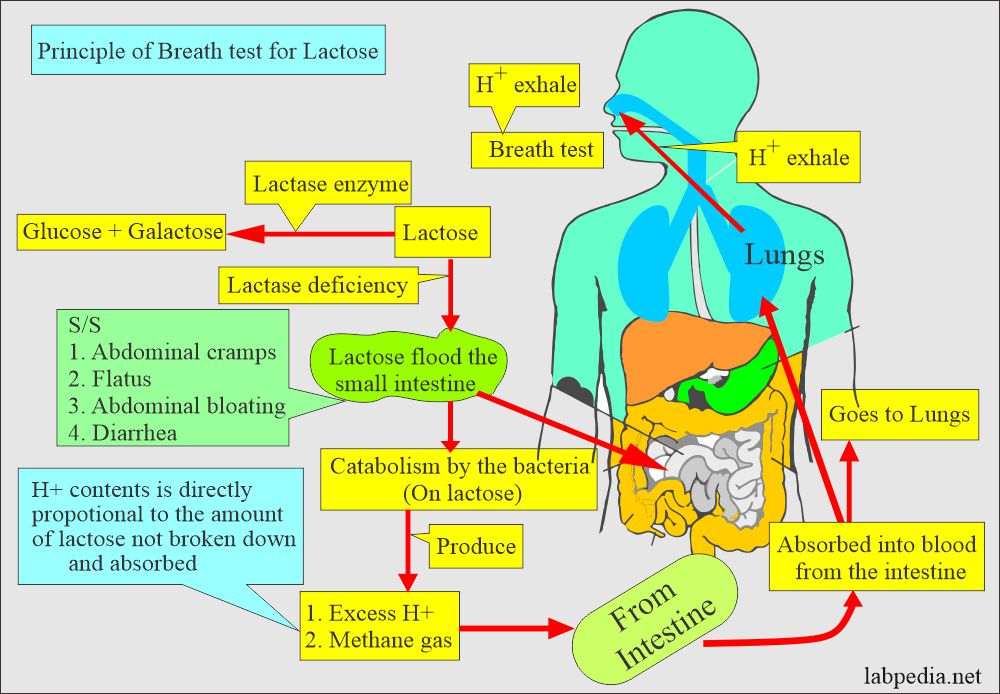
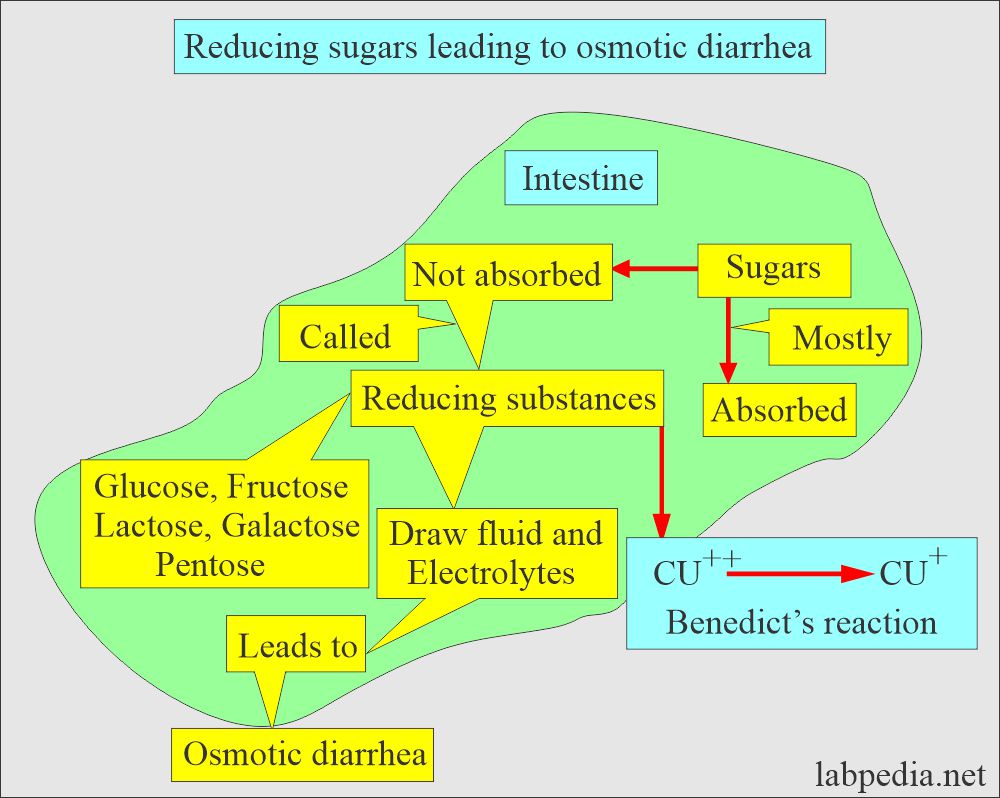

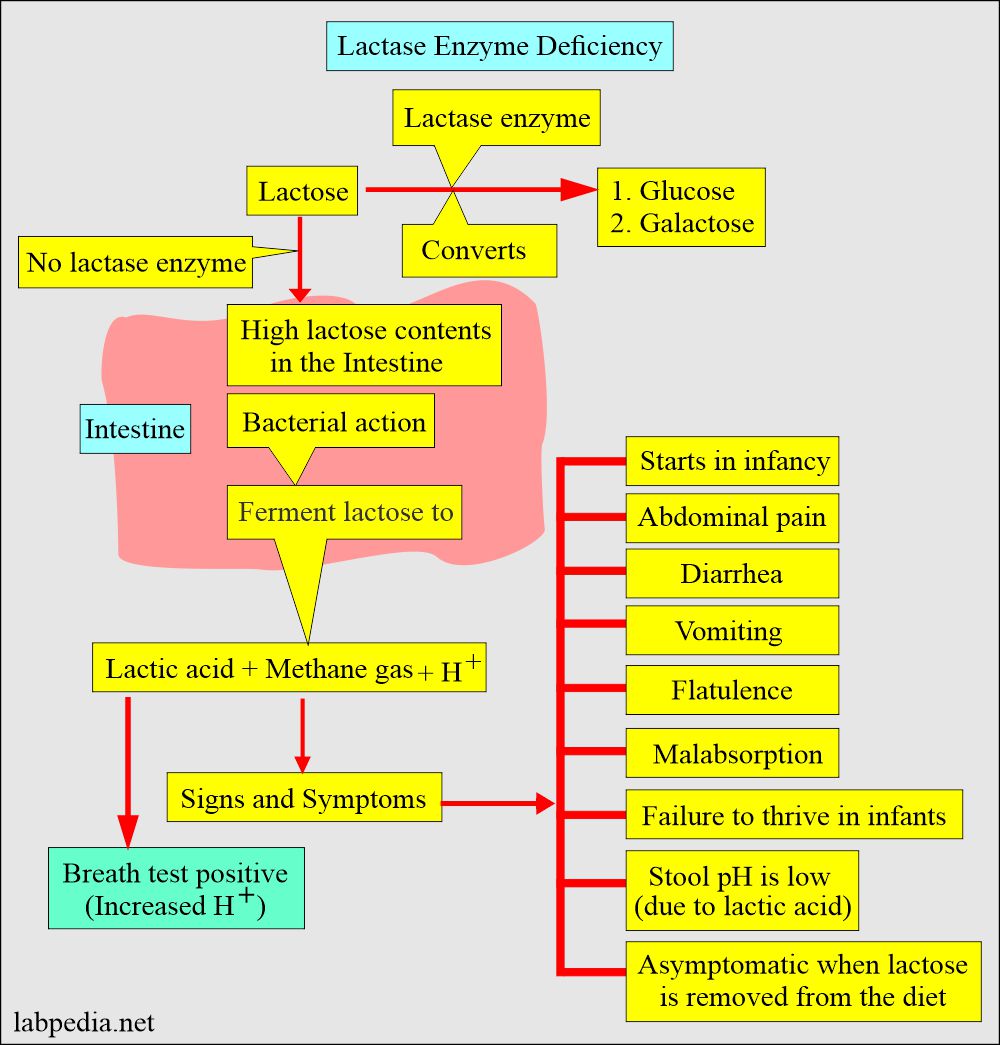
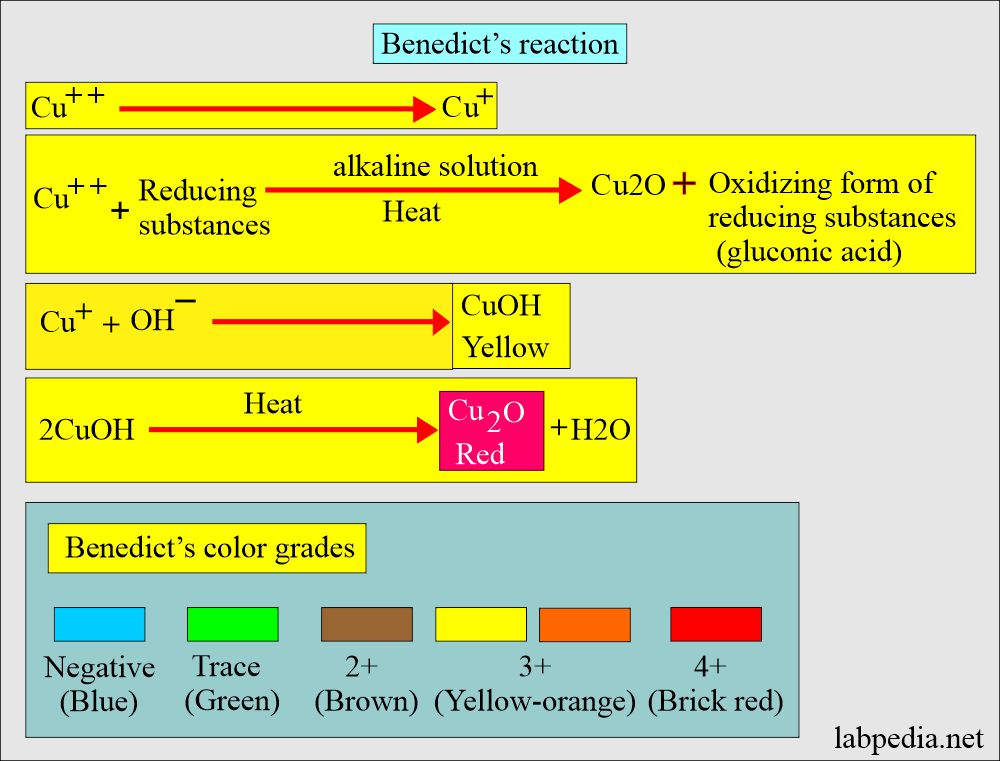
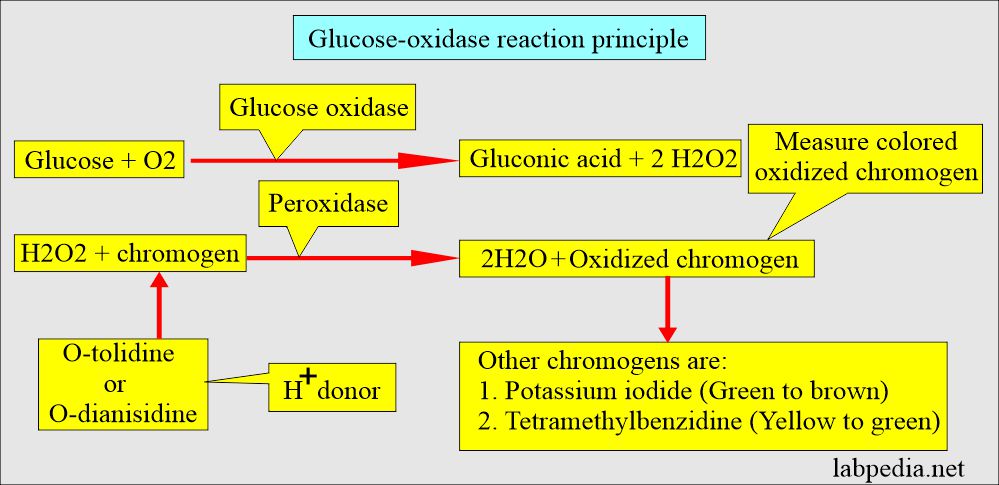
very helpful notes indeed ,i have been updated
Thanks.
thank you Dr. riaz you helped me a lot
Welcome.
Nicely explained!
Thanks.
I’m a lab scientist from Ghana. Thanks Dr. Riaz for making these concept easy to assimilite
Thanks a lot for the encouraging comments.
Informative….. thanks
Thanks.
Informative. Thanks a lot.
Thanks.